THE CONFEDERATE NAVY (CSS)
The confederate fleet was actually more the amount of ships that were seized in the Confederate ports and captured or requisitioned vessels than a coherent pre-existing fleet. The Confederates tried to cope with the huge industrial and technical resources of the Union, massive private arsenals, engineers and manpower, while trying revolutionary concepts as the Hunley or the David in one hand, and by auxiliary cruisers, corsairs, and blocus enforcers on the other.
The most famous of these is undoubtedly the CSS Shenandoah. Mastership of the Mussissippi during the war urged a number of riverine ironclads to be built on the basis of converted civilian vessels, corvette and frigates, but with a conventional battery side: Only the Union owned Coles turrets patents. The enduring embargo prevented the South to purchase it, athough many warship were ordered from British, French, or German arsenals.
The Confederate fleet:
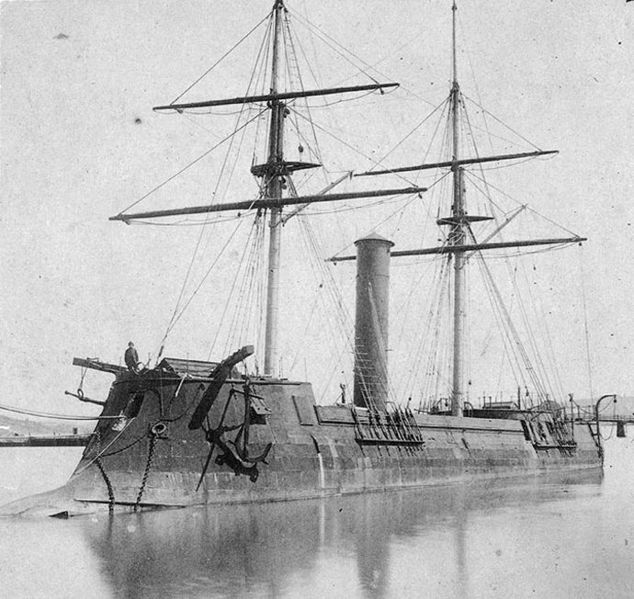
CSS Stonewall (1865)
Ironclads :
The Confederate leaders affirmed their determination to counter the classic, massive northern fleet through the purchase abroad of ironclads. Knowing this, Union government strongly pressured and threatened the European states to agree. Also, only the CSS Stonewall was built and finished in Bordeaux in January 1863 in semi-secrecy, under the cover name of another country. She was to be operational by the end of the war, but at her first cruise, encountered two union units on the Spanish coast and offered them a duel, that they rejected. (Read more about css Stonewall).
During the whole duration of the war, the confederacy was not able to afford a suitable engineering industry and in result were not capable to built a sophisticated ship equivalent to the USS Monitor. This does not prevent them to build several powerful riverine ironclads : First, the CSS Virginia, formerly Merrimack, which was made immortal by his duel with the Monitor near Hampton road, resulting in a draw. However, the CSS Tennessee CSS Atlanta, Charleston, Frederickburg, Arkansas, Richmond, Raleigh, North Carolina, Chicora, Neuse, Palmetto State, Savannah, Ablemarle, Huntsville, Tuscaloosa and CSS Nashville were also converted ships which served as such, some with only a massive wooden protection and a thin layer of iron.
Commerce Raiders :
The confederacy armed some captured or seized trading clippers to undermine the union trade lines, and also to enforce the blockade. There were in service under the southern colors as the CSS Sumter, Florida, Alabama, Georgia, and Shenandoah ot Talahassee. There were also a number of specialized blockade runners, as CSS Hope. All were manned by determined crews and effectively disrupted the Union trade lines, resulting in a general chase over the Pacific and the atlantic as well…
The Shenandoah herself, formerly the famous clipper Sea King, was one of the most successful of these ships, sinking 38 whalers, resulting in a substantial economical loss for the Union (whale oil was one of the most valuable trade export good at this time by far). But the prize was owned by CSS Alabama, sinking or capturing 65 ships.
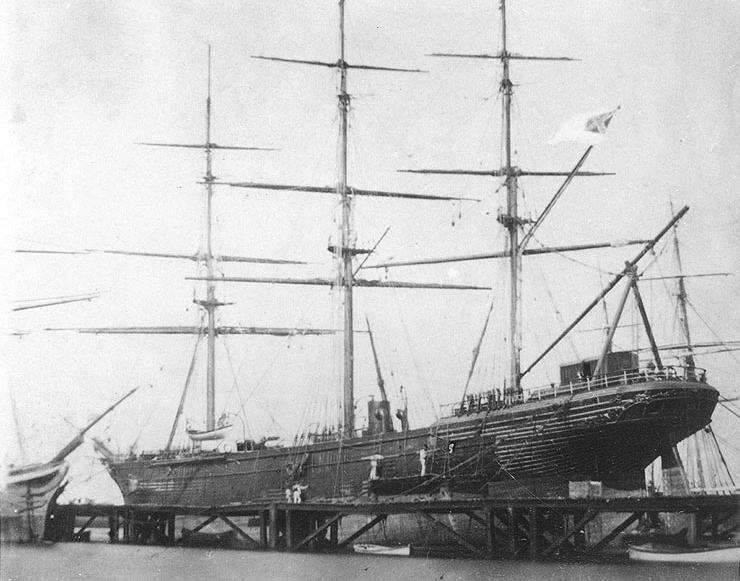
CSS Shenandoah
Special vessels :
These were the truly revolutionary CSS David, a semi-submersible carrying an explosive charge at the end of a long spar, and the CSS HL Hunley, the first real submersible, moved by human power. Both deserved some limited success. The CSS Manassas was another former civilian ship, converted into a kind of ironclad gunboat ram, able to deflect projectiles on her turtleback hull as well as being partially submersible. She was one of the most stunning ship in service during the war, although she overall performed poorly.

Battle of CSS Alabama off Cherbourg by the famous painter Manet
Confederate naval strategy
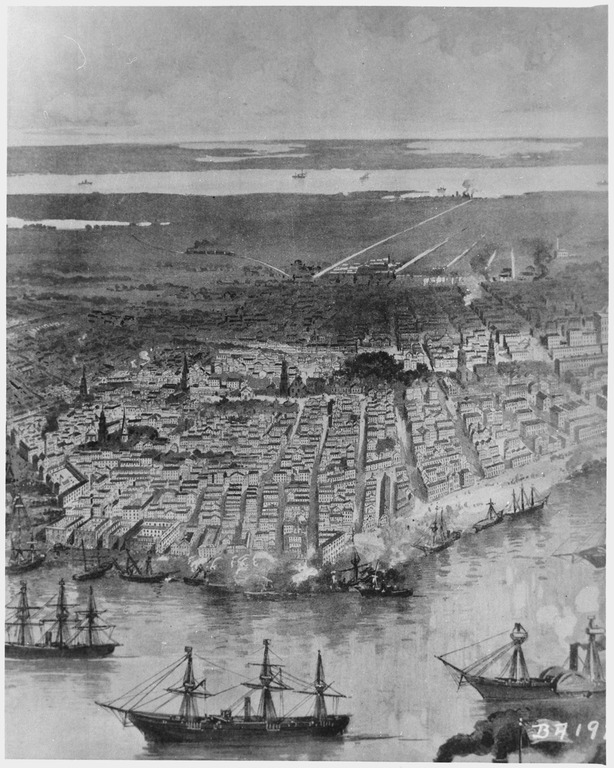
Confederate Fleet in New Orleans, 1862
Three major tasks were the protection of Confederate harbors, coastlines (from invasion) and attacking Union shipping worldwide, drawing them awau from the blockade. Besides this, there was no way such a tiny Navy, historically born from nothing and pitted against the whole of United States Navy. In this unequal struggle, the Confederates could not compete in terms of quantities and of quality.
But it was possible to disrupt the scheme through technological innovation, with ironclads, submersibles and semi-submersibles, spar torpedo boats and mines. This particular weak to strong relation would later inspire most budget-restrained coastal fleets and third rank navies surrounded by powerful neighbours in Europe. It was a naval extrapolation at sea of the “guerilla war”, as no major, decisive naval battles could be possible, at least until the great clashes on the James River.
Limited Confederate assets
By February 1861, the Confederate States Navy could only muster 30 vessels. And of this total only 14 were really seaworthy. Opposing them, the Union Navy had 90 vessels, including sailing frigates and three-deckers. In addition, the lack of industrial facilities and resources limited the numbers of ships that can be converted, let alone built. However, the dedication of its personal to the cause eventually raised this total to 101 ships, while the Union Navy grew to over 500.
But problems were real: The Confederates could not manufacture, boilers, and engines, nor roll iron sufficiently thick for plating. Wood however was present in quantity, and was used as a buffer, with only and armored surface. Due to the Northern blockade over imports of metal, New Orleans shipbuilders had to bring iron and machinery from Virginia by rail, using a poor system barely fitted for the task. Imports were not stopped, but limted to the high cost of transportation.
In fact it was established the South needed some 50,000 tons of rail annualy, just to serve adequately the army in the same way the North did, let alone carrying bulky materials. The naval transportation option of the same, from Europe, was also dropped and small-volume, high value commodities were preferred on blockade-runners.
Fortunately in April, 20, the Union was forced to flee the Gosport Navy Yard at Portsmouth, Virginia, failing to set fire to the immense reserved that were stockpiled there. This fell as a gift from heaven for the young navy, with a solid supply on which a small fleet can grow operationally. Not only the Confederacy obtained a stock of heavy cannon, gunpowder, shot and shells, but also precious drydocks, the only ones south, able to accomodate repairs, conversions and construction of ships. The only other naval facility was Pensacola in Florida.
Also, the only significant warship the Confederacy laid her hands upon was the scuttled and left partially burnt frigate Merrimack, soon converted into the first riverine ironclad of the war, known as CSS Virginia. Many would follow under the supervision of Confederate Navy Secretary Stephen Mallory.
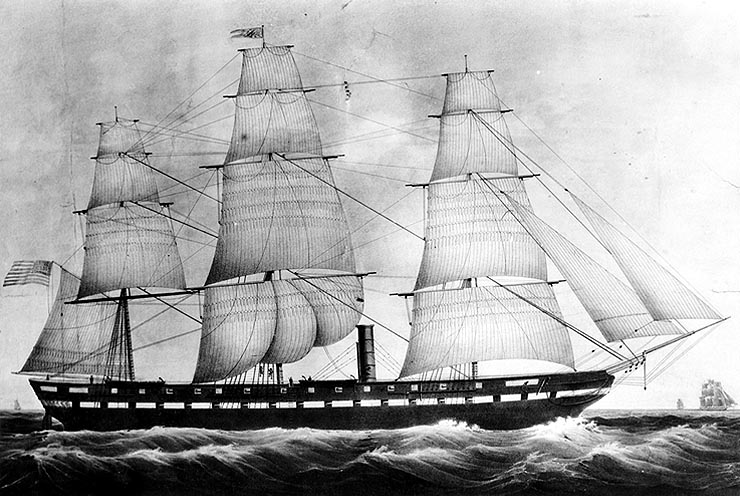
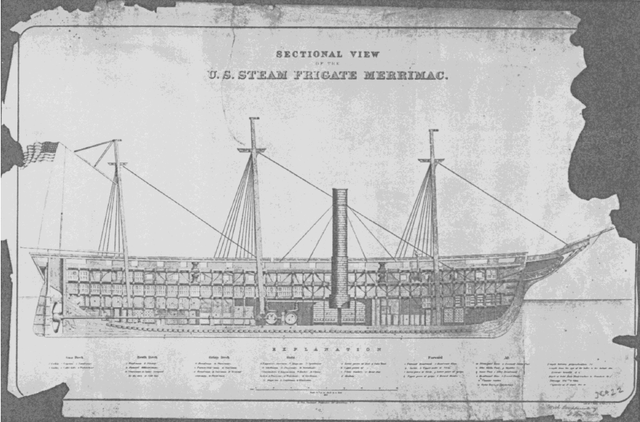
The 1855 Frigate USS Merrimack, burnt and sunk to prevent capture. She was very significant warship in the tradition started in 1797, wooden-hull with copper-plating for her underbelly, a steam engine for 12 knots and 40 guns on two decks. She was one of six vessels named after rivers.
The case of the Virginia: First Ironclad
The idea of converting the ship as an ironclad was at first dictated by practical considerations. The ship was burnt entirely but for the lower part of the hull, and after being salvaged, the boilers and engines could be repaired and made operational. Deprived of all her superstructure, it would have made little sense to rebuilt her as a fully rigged vessel, which was long and complicated. Instead, engineers of the Confederate Navy led by Lt. John Mercer Brooke turned to already six years old events that happened in Crimea.
In 1855 indeed, at the same time these American Frigates were made, French armored floating batteries duelled with Russian forts and won. It proved the superiority of hardened iron armor over earthwork, and for the first time, the threat caused by coastal fortifications to ships evaporated, while the roles were reversed.
In 1859, only four years after, the Gloire was launched. This first sea going ironclad provoked a sismic wave in admiralties and soon the Royal Navy replied with the first all-iron sea-going ironclads. A new race was on, after the conversion of many ships of the line to steam. This was a craze that will only bounce once later in time, with the Dreadnought. But the revolutions in artillery, with new rifled, breech-loaded, long range models mounted on traverse frames, and turrets were just lurking in the corner.
For now, the most recent innovation has been the Paixhans shells. This combination of explosive shells, breech-loaded guns, steam engines propulsion only and a wooden casemate with sloped sides covered with iron plates made perfect sense to the Confederacy, and logically were the solutions chosen against the largely traditional wooden fleet the Union had. To compensate for the lack of armor plates, the South improvized with the slanting wooden structure covered with 4-inch-thick iron casements forged from railroad tracks (which further reduced the railroad maintenance capabilities).
In other cases, railroad tracks were used directly, alternated in encased ‘H’ patterns. The system created the first “modular armor”, for which it was easy to replace a damaged track, without reforging anything. That was the same system used for millenias by scale-armor, as the tracks were mutually supportive as well and they moved freely when hit, reducing the impact by redistributing forces laterally like a metal ripple. It was so effective the Union also copied the system.
All in all, the Confederate ironclad would have been like a wolf dropped into a sheeps den. And indeed whe the Virginia was sent to meet the James River Squadron. Ships after ships were pounded and sank, and the blockade nearly broke off until the Monitor showed up and engaged the Virginia, but the match ended as a draw. But the deponstration was enough to motivate the Confederacy to launch other conversions, not always as successful and some short-lived. Of course, the Union could not be left on this race and multiplied its own line of “monitors” from the lead ship, with a revolving turret instead of broadsides, and many riverine ironclads (like USS Cairo).
The race for ironclads: Two approaches
Aside these conversions, from May 1861, the Confederate Congress appropriated $2 million in order to purchase ironclads from overseas. The idea was the purchased ships can sail with American sailors passed through inside blockade runners and commissioned the ships at sea, and then forcing they way in through the blockade. Back in Europe, this first duel of ironclads showed steam-only armoured warhips were a way forward, and masts began to disappear in a gradual process.
In 1880, full rigging was no longer required and the only ships staying in a mixed configuration were gunboats. The other consequence of the duel was that 11-in guns seemed incapable of piercing armor, and Assistant Secretary of the Navy Fox soon asked to test 15-in, and soon 18 and even 21-in guns. This choice was compounded by the decision in December 1861 of Secretary Welles to order 21 monitors, all armed with 15-in guns, waiting for the 21-in turrets.
Submarine warfare and mines
To an average street person, the term of “submarine warfare” applied to the American Civilian war seems far-fetched. But in recorded history, after 1812 and Bushnell’s unsuccesful attempts, using submersibles in wartie, with success, appeared first in the American civil war. To bring an explosive charge on a ship’s flank (called a spar torpedo) seemed well complemented by a ship able to survive a broadside. It was to be slow, and protected in some way. Instead of building an armored ship for the task, southern engineers advocated simple ideas based on two ays to make a projectile bounce off: Using turtleback hulls and having the ship submerged in a way water itself protected it.
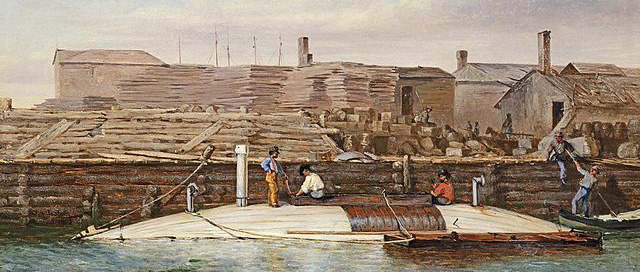
Conrad Wise Chapman – Painting of the David at Charleston Dock, 25 October 1863.
Indeed as it was shown in many experiences, including one with high velocity bullets, the density of water was such that terminal velocity was reduced to zero in a matter of a fraction of a second over a distance ranging from 40 cm to one meter of penetration. A “soft” armour, but a way to break the projectile velocity. It was even more true with large and bulky marine shells fired a low velocity. Turleback semi-submerged spar-torpedo vessels were just a perfect combination of “soft protection”, avoiding iron-plating a ship, which was expensive, and allowed to built more of these early “torpedo-boats”.
From the theory, many confederate “secret weapons” emerged from a single vessel: The David. Shaped with a cigar, or an eatly torpedo, this wooden and metal vessel had ballast tanks in order to be submerged, but just enough for the top to be kept over the waves, and ensuring ventilation and funnel exhaust and left only a small pilothouse emerging. Indeed, steam-powered, the David was even painted in dark blue for concealment and used by night to bring down chances of being spotted. A 100 pounds explosive charge with percussion was carried in the end of a long spar, maintained straight by a cable. These had success in Charleston harbor, the CSS david or one of its twenty clones succesfully damaged the USS New Ironsides, sent back to repairs for a year. This was a tremendous success, given the fact this was the only real sea-going ironclad the Union possessed.
See also NAVAL STRATEGY DURING THE AMERICAN CIVIL WAR (pdf)
(Work in progress)
Confederate ships nomenclature
CSS Virginia
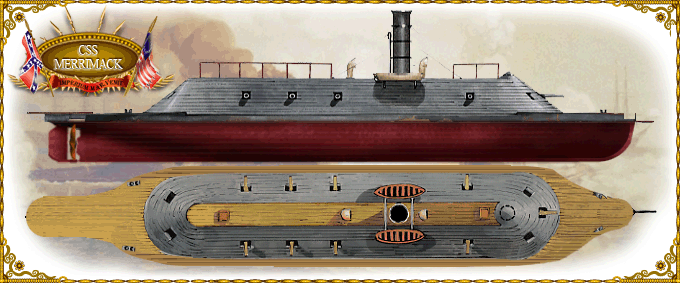
CSS Merrimack was the first (and last) all-metal protected casemate ironclad built by the Confederacy, to counter the naval supremacy of the North, but without the industrial resources able to replicate Coles turrets which the south was also deprived because of the embargo.
The CSS Virginia battled for the first time her opponent, the USS Monitor during the famous Battle of Hampton Roads in 1964, who remained undecided after half an hour’s point blank cannonade.
After that she tried unsuccesfully to breach the blockade, making dozens of attempts before then war ended, she never fought the monitor again and has to scuttle itself while blowing here magazine, to prevent her from falling into enemy hands when the union took Norfolk, on may, 11, 1862.
The Merrimack concentrated all available skills to cover a framed casemate with iron plates, turning one of the six a frigates authorized by the congress and built there (USS Virginia) to an almost unsinkable ship. Against the Monitor, her only duel ended as a draw.
Weight & dimensions: 3100 t ; 83,81 x 11,73 x 6,70 m
Propulsion: Steam only – 1 Penn Trunk screw, 4 Martin boilers, 440 hp, 6 knots.
Armour: sides 4,7 inches on oak, iron, oak sandwich
Armament: 2x 7in Brooke RMLs, 2x 6,5 in, 6x 8,5in mortars, 2x 3in Howitzers.
Crew: 85
CSS Alabama (1862)
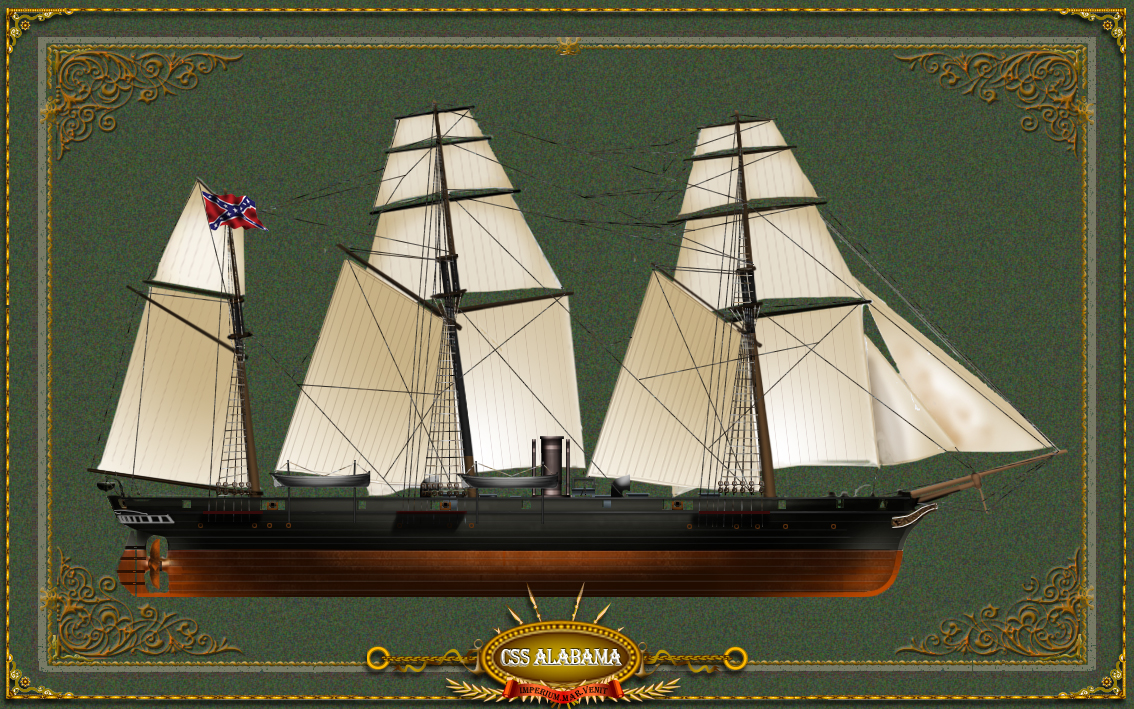
This famous ship was the most successful of all Confederacy commerce raiders. She took no less than 69 union ships as prizes, and sank the Union gunboat USS Hatteras off Texas. She roamed the north and south Atlantic, west and east indies, South Africa, and its career ended in June 1864 when she was refitted and replenished at Cherbourg, France. USS Kearsage, precisely hunting for the commerce raider, arrived and stand by at the entrance of the harbour, offering combat.
Alabama then ready engaged an epic duel, the two ships exchanging some 250 shells before one struck Alabama below the waterline, consequently sank her. It is estimated that during her two years of cruising she costed to the union more than 6,000 000 dollars of estimated total value of lost shipping.
Originally known as Laird “Hull 290” at Liverpool John Laird & sons Yard in Great Britain, she was completed as the Barque steamer Enrica, with a lifting screw to serve as a steam clipper. She taken over by the confederate government and completed as a commerce raider, left Britain in July 1862 and then roamed the seas until 1864.
Weight & dimensions : 1050 t ; 67,05 x 9,65 x 4,26 m
Propulsion : Steam only – 1 lifting screw, 4 Martin Boilers, 800 hp, 11 knots.
Armour : None
Armament : One 6,4in Blackely RML, one 8prd SB, six 32pdr SB.
Crew : 145
CSS Manassas (1861)
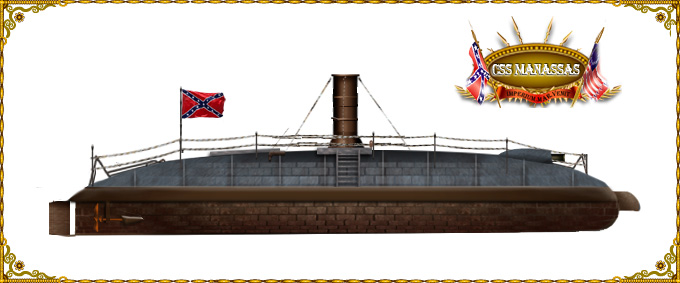
Commissioned in September, 12, this armoured ram was designed with a very low profile, capable of deflecting any shell at any angle. The only protruding structures were the chimney and the forward protective shield over its only gun, a 64pdr Dalghren BL (later reduced to 32).
But its main weapon was a sturdy ram. The ship was nearly twice as heavy as the original ship despite her low silhouette, and ramming speed was relatively slow. But she successfully rammed USS Richmond at the battle of the head of passes, and then later, on her way to New orleans, rammed USS Mississippi and Brooklyn.
Neither was sunk, but their hull suffered heavy damage. After that on 24 april, 1862, she was charged by Mississippi, but while dodging this attempt, ran aground and was subsequently pounded furiously Mississippi and definitely disabled. However, the crew managed to escape.
This “hellish machine” as it was dubbed by Union intelligence, was the former icebreaker and towboat Enoch Train, built in 1855 at Medford, Mass. It was converted in 1860 by privateer Capt. John A. Stevenson at Algiers, Louisiana, with a surprising, radical, yet very effective design, featuring an ironclad turtleback.
Weight & dimensions : 385-387 t ; 44 x 10 x 5,2 m
Propulsion : Steam only – 1 screw, 2 Boilers, 180 hp, 8 knots.
Armour : Full iron plating, 25-30 mm, 2 inches aw
Armament : One 64pdr Dalghren BL, ram.
Crew : 36
CSS Shenandoah (1864)

This ship left britain on october, 8, 1864, and was officially commissioned the 19 of the very same month. So her career was short but very active : She took no less than 38 ships, mostly whalers (whale oil was highly priced at this time, weakening the union revenue at some degree), and most surprising, almost two third after the war ended… She surrendered to Britain while coaling, on november, 6, 1865, after a relentless one-year campaign.
CSS Shenandoah was one of the top list, most chased Confederate commerce raider in the world. This indian transport, laid up at Stephen in 1864 (UK) and named Sea King, was purchased as a commerce raider by the confederate government, with added firepower. She has a composite hull and lifting screw, one compound engine, but was as well rigged as a clipper.
Weight & dimensions : 1140-1160 t ; 70,11 x 9,75 x 6,25 m
Propulsion : Steam and sail – 1 screw, 2 Boilers, 190 hp, 9 knots.
Armour : Only extra wooden layers on broadside deck
Armament : Two 32pdr Withworth RML, two 12in, four 8in.
Crew : 36
CSS Sumter (1862)
CSS Sumter (named after fort sumter seizure), formely the Habana of the Mc Connell line of New Orleans, was built at Philadelphia in 1859 as a barque-rigged steamer, purchased in april 1861 and modified as a commerce raider, commissioned in june 1861. She has a breef career were she took 18 prizes, before laying up and beeing sold at Gibraltar. She then became the British blockade runner Gibraltar.
Weight & dimensions : 437t ; 56,07 x 9,14 x 3,66 m
Propulsion : 1 screw, 2 Boilers, 100 hp, 10 knots, coal for 8 days.
Armour : Extra wooden layers on broadside deck
Armament : One 8in SB, four 32pdr SB.
Crew : 51
CSS Florida (1861)
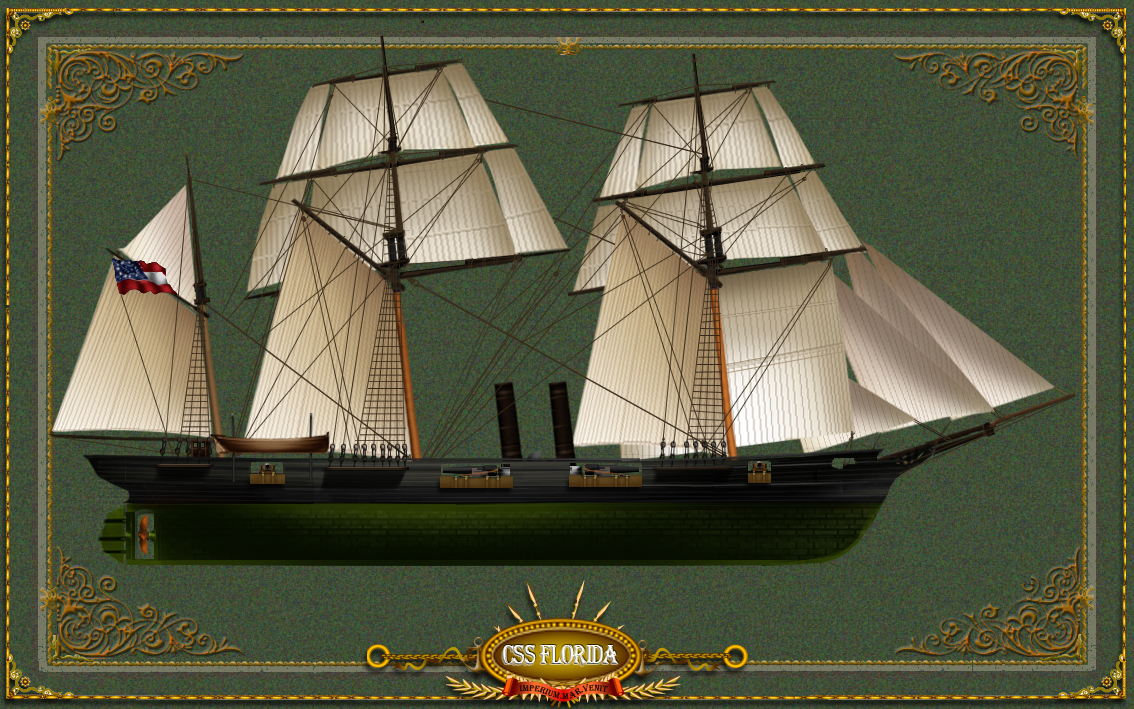
Originally the british built SS. Oreto she was bought by the confederate owned Fawcett, Preston and co. of Liverpool and converted while on the stocks as a heavily armed confederate raider. She was equipped with four Blakely guns in broadside position on the rear and front of the hull, and two other, more massive 7 inches on the axis between the masts and funnels.
This configuration gave them a broadside of four guns. The 32 pdr smoothbore cannon was a chasing one. Her career was complicated. She departed from UK in march 1962 then joined Nassau (Bahamas) for coaling and headed and refitting, being commissioned as CSS Florida in august. Lieutenant John N. Maffitt then took command but the crew was then badly stricken by disease (yellow fever). However she joined Cuba, but as the situation worsened, Maffitt himself being in bad shape, managed to pass the union blockade and eventually reached the guns of Fort Morgan at Mobile to be welcomed as a hero.
Under the command of her daring captain, the prince of privateers, she roamed the southern and northern coast of America. She fled to Brest in august, 1863 for refit, and then headed for Bahia. He crew was half ashore when taken by surprise by a daring night attack lead by Commander Collins of USS Wachusetts. But as Brazil was neutral, a trial followed and CSS Florida, then sailing to Hampton roads, sank (probably intentional) in November, 28, 1864. During her long career she took 37 prizes, and her sailing tenders themselves 23 more, totalling 60.
CSS Florida was well recognisable with her twin tall funnels, and raked masts. Originally known as Oreto, built at W C Miller in 1861 of Liverpool, seized by the Confederacy, relaunched in 1862 and armed with six massive Blakely rifled guns. She became one of the most hunted confederate ship ever.
Weight & dimensions : 480t ; 58 x 8,28 x 4 m
Propulsion : 1 lifting screw, 2 Boilers, 90 hp, 9,5 knots, coal for 10 days.
Armour : Extra wooden layers on broadside deck
Armament : Two 7in and four 6,4in RML, one 32pdr SB.
Crew : 146
CSS Atlanta (1861)
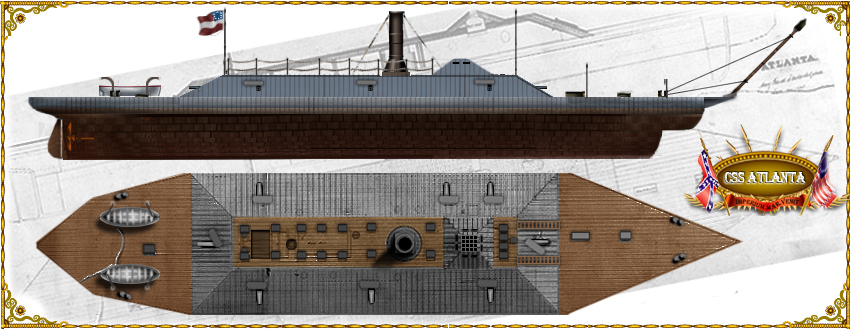
The ship was scheduled for departing in Scotland with cotton but events prevented it, and instead she was converted entirely by june, 1861 into a formidable ironclad, serving under both sides during the war. It was operated on the savannah river and first displayed in action against Unions blockaders.
However, obstructions blocking the channel prevented any action at hampton roads or in open seas. On june, 15 of july under the command of capt. William A. Webb, accompanied by two CS steamers, the Isondiga and Resolute, she tryed to blow up the monitor USS Weekhaven, but because of her deep hull, ran aground instead and fired at point blank range by Weekhaven and USS Nahant, and with most of her crew and guns disabled, was forced to surrender.
Then Atlanta began a second life under the stars and stripes, beeing re-commissioned after some modifications, in february 1864. She fought on the James River to support Grant\’s operations and defended fort Powhatan under CS attack. Finally, USS Atlanta was decommissioned in june 1865 and sold on auctions to Haiti, but capsized and sunk while en route at Cape Hatteras in december 1869.
This was the former merchantman Fingal, built at Glasgow, Scotland, launched in may 1861, which began her career as a blockade runner, rallying the Bermuda islands, then heading in Savannah, with a full load of rifles, guns and ammunitions.

Weight & dimensions : 1022t ; 62,2 x 12,5 x 4,8 m
Propulsion : 1 screw, 1 Boiler, 220 hp, 10 knots, coal for 10 days.
Armour : Casemate : 102 mm -hull : 51 mm
Armament : Two 7in and six 6,4in Brooke RML, spar torpedo.
Crew : 145
CSS HL Hunley (1863)
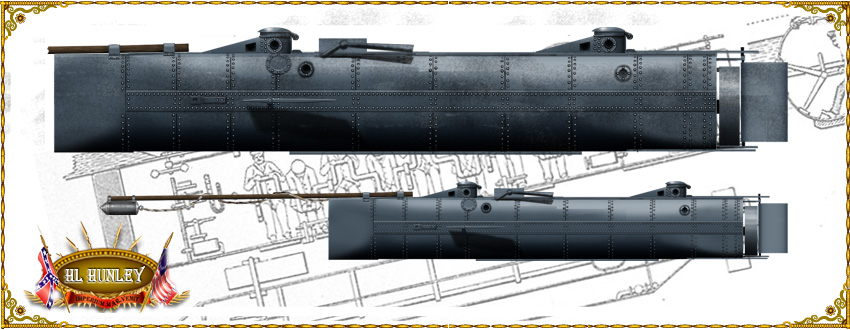
This was an early precursor of modern submarines, despite the fact it was human-propelled, it introduced many features which became standard later. It was also a vicious, unforgiving machine which killed three crews, including its own creator, but successfully led the last attack, conducted by Lt. Georges S. Dixon under command of gen. PT Beauregard in charge of Charleston defense.
In feb. 18, 1864, HL HUNLEY (formerly the Fishboat) joined the less defended second-line blocus ships and attached its spar torpedo to the bottom hull of the wooden-built Sloop of war USS Housatonic, bringing it to the bottom with almost all crew. Probably the concussion resulting from the blast created some breeches inside the hull of the submarine, which was flooded and lost with all hands, then rediscovered in 1955, and now a museum.
This extraordinary machine was conceived by Horace Lawson Hunley, which seen as early as 1861 that Confederates were ill-prepared to withstand any union blockade. He designed at Mobile with John Mc.Clintock a steel, cigar-shaped, human propelled device which was capable of being submerged and delivering a mine.
Weight & dimensions : 6,8 to 8t ; 12,04 x 1,17 x 1,80 m
Propulsion : 1 screw, manual crank for seven, speed 4 knots.
Armour : None – 10 mm steel
Armament : One wired spar torpedo.
Crew : 8
CSS Chicora (1862)
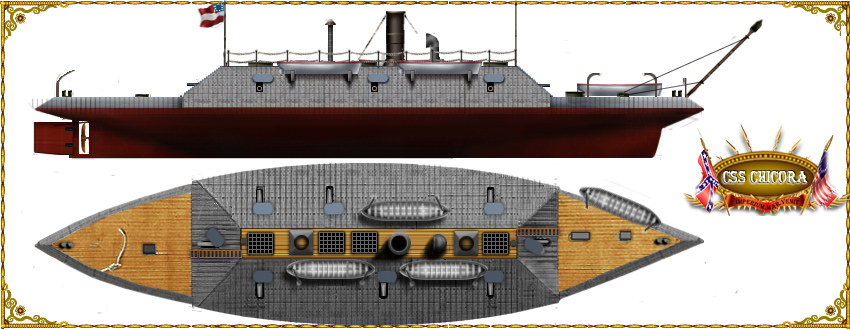
The CSS CHICORA was a purpose-built ironclad which costed around 300000 $, part of a confederate state appropriation.
The Chicora It was started in march and launched at Charleston in june 1862, by James M. Eason on John L. Porter plans, and commissioned in november, Eason beeing praised for its promptitude, taken in hands by commander John R. Tucker.
It was a fairly wide and thickly armored ship despite the fact her armament was only four rifled Parrot guns at the beginning. Soon after the start of its operations, she was equipped with two more guns and a spar-torpedo.
In January, together with CSS Palmetto States, she raided the blockading force at the entrance of Charleston, forcing to surrender USS Mercedita, and badly damaged USS Keyston State, as well as engaging other ships, which them to retire.
In april, she was attacked by an ironclads squadron commanded by rear admiral Francis Du Pont, and was damaged. She took refuge inside Charleston docks. After that, she tok part in many operation until beeing scuttled in 1865.
Weight & dimensions : 830 to 880t ; 46 x 11 x 4,3 m
Propulsion : 1 screw, 2-stroke steam engine, 2 boilers, speed 5 knots.
Armour : 4in (127 mm) steel backed by 22in oak planking.
Armament : spar torpedo, 6 32pdr rifled guns.
Crew : 150
CSS David (1861)

The CSS DAVID was born of a private venture, ordered by T. Stoney of Charleston. It was designed as a semi-submerged spart torpedo vessel, aiming to destroy enemy blockading ships by moonless nights, with a smokeless propellant.
The David (a self-speaking reference to david vs goliath in the old Testament – reflecting the very nature of the unequal fight of the confederate navy) made several sorties, the first one beeing led against the USS New Ironsides, which was slightly damaged. In several occasions, the explosive failed to detonate or the attacked ships evaded it. From the fall of 1963 to the capture of Charleston, the David attacked many ships, but failed to sink a single one. She was probably captured in february 1865 when Charleston fall.
Weight & dimensions : 8 to 10 tons ; 15 x 1,8 x 1,5 m
Propulsion : 1 screw, 2-stroke steam engine, 1 boiler, speed 6 knots.
Armour : none – iron plating.
Armament : spar torpedo, 60 to 70 pounds of explosives.
Crew : 4
CSS Savannah (1863)

The Savannah was one of the first ironclad beeing built from scratch at H.F.Willink from Savannah, launched in january 1843 and put in service in june 1963. Her Armour was a mix of twin 2 inches iron plating backed by 21 inches of timber, on a 35 degree slopes.
Speed was six knots and the crew comprised 160 men and a Marines company, manning the ship and its four guns, two pivot Brooke guns posted fore and aft firing from three portholes, and two broadside shifted guns.
After a long carreer defending Savannah harbour as a flagship, she was burned by its own crew to prevent capture when Savannah falled, not before expended all its ammunition against USN batteries and infantry positions while defending the city under siege in december 1864.
The CSS Savannah, of the Richmond class, was designed by eng. John L. Porter to the request of the Confederate Navy department in order to standardize equipments, and provides guardships for harbours and coastal duties.
Weight & dimensions : Around 600 tons ; 46 x 10 x 3,8 m
Propulsion : 1 screw, 2-stroke steam engine, 1 boiler, speed 6 knots.
Armour : 2x2in iron plating on 21in timber.
Armament : two pivot 7in and two 6.4in Brooke RML.
Crew : 180


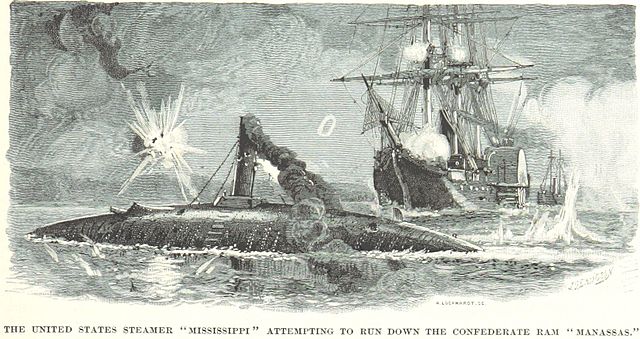
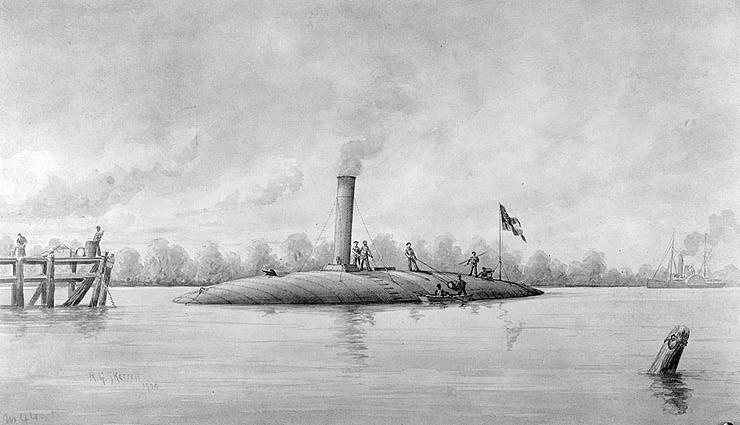

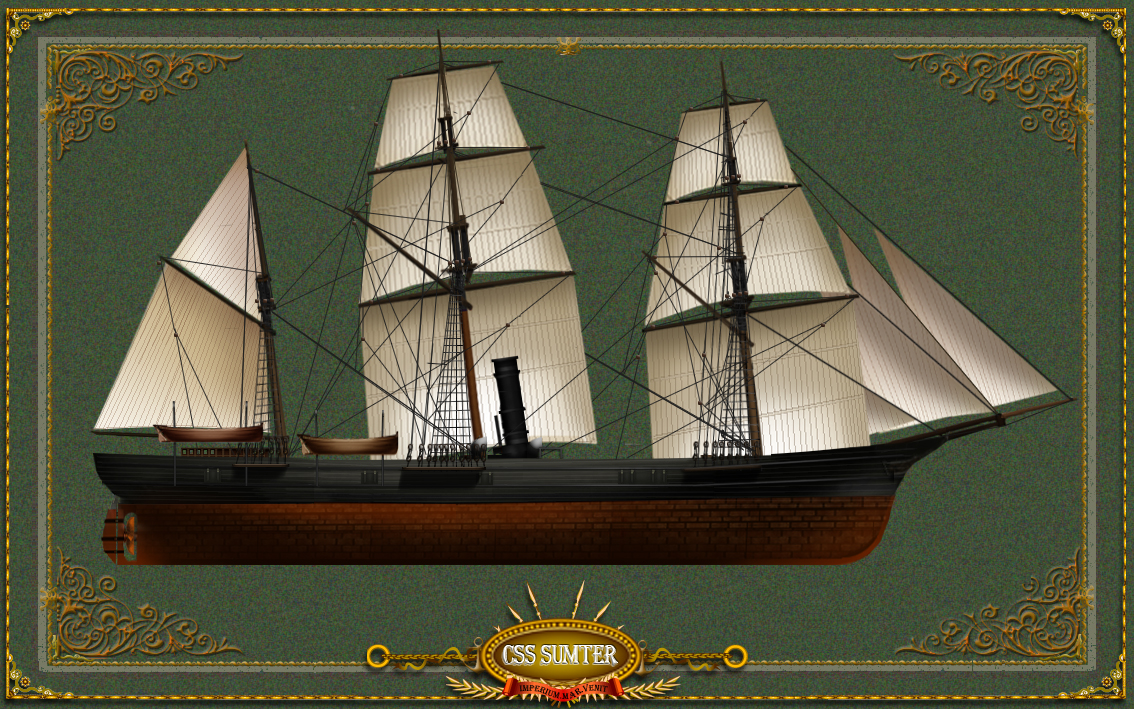
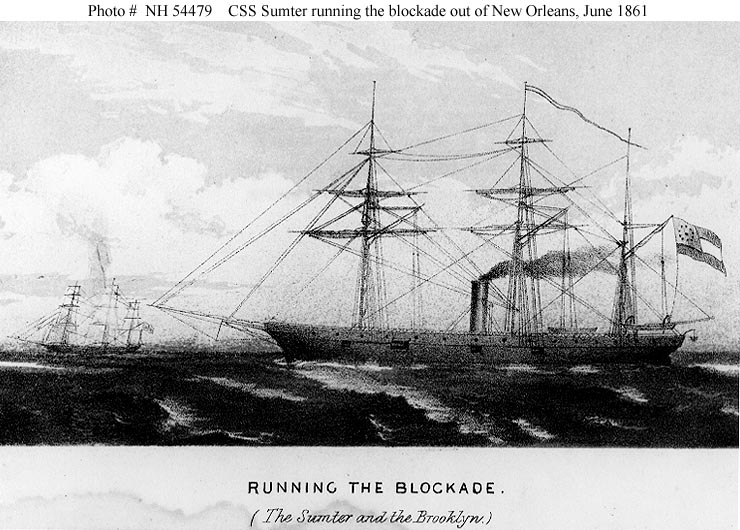
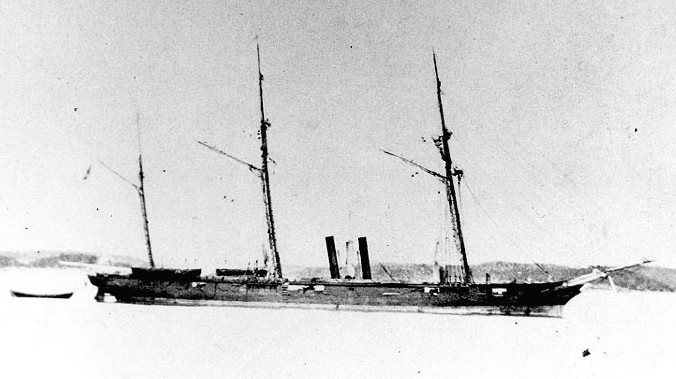
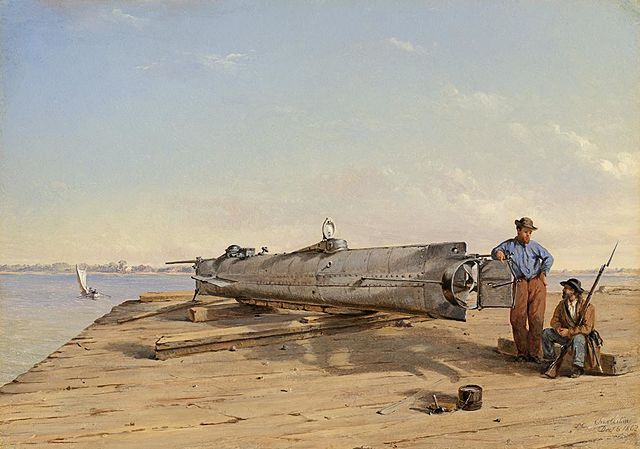
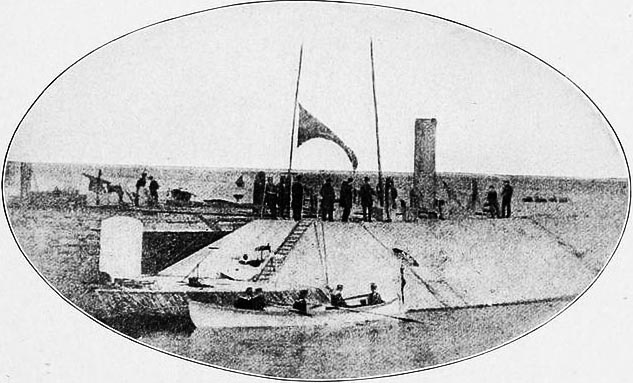
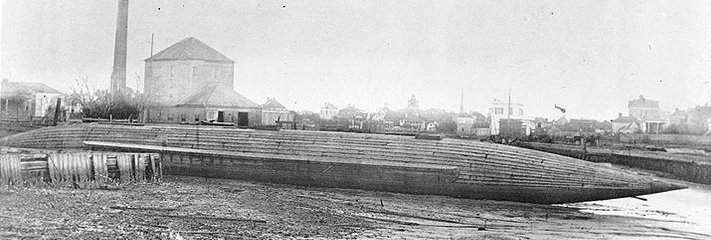

 Latest Facebook Entry -
Latest Facebook Entry -  X(Tweeter) Naval Encyclopedia's deck archive
X(Tweeter) Naval Encyclopedia's deck archive Instagram (@navalencyc)
Instagram (@navalencyc)





 French Navy
French Navy Royal Navy
Royal Navy Russian Navy
Russian Navy Armada Espanola
Armada Espanola Austrian Navy
Austrian Navy K.u.K. Kriegsmarine
K.u.K. Kriegsmarine Dansk Marine
Dansk Marine Nautiko Hellenon
Nautiko Hellenon Koninklije Marine 1870
Koninklije Marine 1870 Marinha do Brasil
Marinha do Brasil Osmanlı Donanması
Osmanlı Donanması Marina Do Peru
Marina Do Peru Marinha do Portugal
Marinha do Portugal Regia Marina 1870
Regia Marina 1870 Nihhon Kaigun 1870
Nihhon Kaigun 1870 Preußische Marine 1870
Preußische Marine 1870 Russkiy Flot 1870
Russkiy Flot 1870 Svenska marinen
Svenska marinen Søværnet
Søværnet Union Navy
Union Navy Confederate Navy
Confederate Navy Armada de Argentina
Armada de Argentina Imperial Chinese Navy
Imperial Chinese Navy Marinha do Portugal
Marinha do Portugal Mexico
Mexico Kaiserliche Marine
Kaiserliche Marine 1898 US Navy
1898 US Navy Sovietskiy Flot
Sovietskiy Flot Royal Canadian Navy
Royal Canadian Navy Royal Australian Navy
Royal Australian Navy RNZN Fleet
RNZN Fleet Chinese Navy 1937
Chinese Navy 1937 Kriegsmarine
Kriegsmarine Chilean Navy
Chilean Navy Danish Navy
Danish Navy Finnish Navy
Finnish Navy Hellenic Navy
Hellenic Navy Polish Navy
Polish Navy Romanian Navy
Romanian Navy Turkish Navy
Turkish Navy Royal Yugoslav Navy
Royal Yugoslav Navy Royal Thai Navy
Royal Thai Navy Minor Navies
Minor Navies Albania
Albania Austria
Austria Belgium
Belgium Columbia
Columbia Costa Rica
Costa Rica Cuba
Cuba Czechoslovakia
Czechoslovakia Dominican Republic
Dominican Republic Haiti
Haiti Hungary
Hungary Honduras
Honduras Estonia
Estonia Iceland
Iceland Eire
Eire Equador
Equador Iran
Iran Iraq
Iraq Latvia
Latvia Liberia
Liberia Lithuania
Lithuania Mandchukuo
Mandchukuo Morocco
Morocco Nicaragua
Nicaragua Persia
Persia San Salvador
San Salvador Sarawak
Sarawak Uruguay
Uruguay Venezuela
Venezuela Zanzibar
Zanzibar Warsaw Pact Navies
Warsaw Pact Navies Bulgaria
Bulgaria Hungary
Hungary

 Bundesmarine
Bundesmarine Dutch Navy
Dutch Navy Hellenic Navy
Hellenic Navy Marina Militare
Marina Militare Yugoslav Navy
Yugoslav Navy Chinese Navy
Chinese Navy Indian Navy
Indian Navy Indonesian Navy
Indonesian Navy JMSDF
JMSDF North Korean Navy
North Korean Navy Pakistani Navy
Pakistani Navy Philippines Navy
Philippines Navy ROKN
ROKN Rep. of Singapore Navy
Rep. of Singapore Navy Taiwanese Navy
Taiwanese Navy IDF Navy
IDF Navy Saudi Navy
Saudi Navy Royal New Zealand Navy
Royal New Zealand Navy Egyptian Navy
Egyptian Navy South African Navy
South African Navy






























 Ukrainian Navy
Ukrainian Navy dbodesign
dbodesign